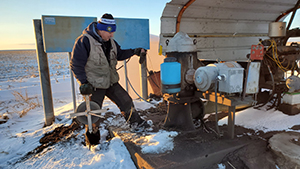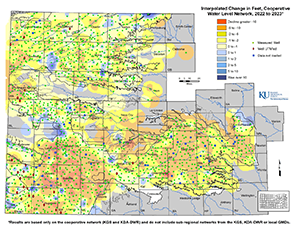
measures water levels as part of a program to monitor
the health of aquifers in western and south-central Kansas.
News Release, Kansas Geological Survey, March 10, 2023
LAWRENCE — Average groundwater levels across western and south-central Kansas fell by nearly 2 feet in 2022, according to preliminary data compiled by the Kansas Geological Survey.
The KGS, based at the University of Kansas, and the Division of Water Resources (DWR) of the Kansas Department of Agriculture measure about 1,400 wells every year to monitor the health of the High Plains aquifer and other aquifers in western and south-central Kansas. Those measurements showed an overall average decline of 1.89 feet last year.
Most parts of the region saw well-below-average precipitation throughout the year. Some areas in Kansas were the driest ever based on historical records, some of which go back to the late 1800s. Dry years lead to increased pumping demands, primarily for irrigation, which in turn typically cause greater declines in water levels.
"We anticipated and saw declines pretty much across the aquifer," said Brownie Wilson, KGS water-data manager. "Because of the ongoing drought, the pumping season lasted a little longer this past year, and there were a notable number of wells pumping in January and February. As such, some of the measured declines will likely be slightly excessive given the aquifer didn't have its normal time to recover."
The overall average decline of 1.89 feet in 2022 is the third largest in 25 years, on a par with the last notable dry years of 2011 (when water levels fell 1.93 feet) and 2012 (a decline of 2.01 feet). It also marked the third straight year of overall declines. Overall levels fell 1 foot in 2021 and 0.89 feet in 2020. Both 2020 and 2021 were abnormally dry years.

At the end of 2022, all 105 counties in Kansas were under a drought watch, warning, or emergency status. As of the end of February, the western and southern parts of the state covered by the groundwater monitoring program were experiencing severe to exceptional drought, according to U.S. Drought Monitor maps produced by the National Drought Mitigation Center at the University of Nebraska-Lincoln, the United States Department of Agriculture, and the National Oceanic and Atmospheric Administration.
The High Plains aquifer is a network of water-bearing rock that extends into eight states. In Kansas, the aquifer comprises three components - the Ogallala aquifer, the Great Bend Prairie aquifer, and the Equus Beds. Of these, the Ogallala aquifer underlies most of western Kansas and consists mainly of the Ogallala Formation, a geologic unit that formed from sediment eroded off the uplifting Rocky Mountains.
Most of the wells in the network monitored by the KGS and DWR are within the boundaries of the state's five Groundwater Management Districts (GMDs), which are organized and governed by area landowners and local water users to address water-resources issues.
In Southwest Kansas GMD 3, average groundwater levels dropped 2.77 feet in 2022, following declines of 2.08 feet in 2021 and 1.25 feet in 2020. The region experienced the most severe drought conditions in the state in 2022, with widespread areas receiving 50 to 75 percent of long-term precipitation averages.
"Precipitation, or the lack thereof this year, is just one variable that goes into water-level changes," said Wilson. "Soil types, evaporation, water availability, and a variety of aquifer conditions are all key factors in how water is used across our state. Southwest Kansas tends to have higher rates of decline but also has some of the greatest thicknesses in the aquifer."
Aquifer thickness is the vertical amount of aquifer that is saturated with water and is an indicator of how much water is in storage.
GMD 3 includes all or part of Grant, Haskell, Gray, Finney, Stanton, Ford, Morton, Stevens, Seward, Hamilton, Kearny, and Meade counties. Most of the wells monitored in the district are drilled into the Ogallala aquifer, except in a few areas where they can also draw from the deeper Dakota aquifer.
Western Kansas GMD 1 saw the smallest drop in 2022 groundwater levels at 1.27 feet. Levels fell 0.57 feet in 2021, and 0.59 in 2020. GMD 1 includes portions of Wallace, Greeley, Wichita, Scott, and Lane counties, where the majority of wells are drilled into the Ogallala aquifer.
"The aquifer in GMD 1 was never overly thick compared to areas north and south and was one of the first areas of the state to have large-capacity wells drilled in the 1940s and '50s. There have been a lot of water conservation activities occurring recently in GMD 1 in response to water levels in much of the district falling to a point that yields from wells have greatly diminished," Wilson said.
Northwest Kansas GMD 4, which saw well-below-average precipitation in 2022, experienced a drop of 1.31 feet in 2022 groundwater levels, after declines of 0.53 feet in 2021 and 0.70 feet in 2020. GMD 4 covers Sherman, Thomas, Sheridan, and parts of Cheyenne, Rawlins, Decatur, Graham, Wallace, Logan, and Gove counties. Groundwater there is pumped from the Ogallala aquifer and shallow alluvial sources associated with streams. Even the well-known Sheridan 6 Local Enhanced Management Area, the first area of its kind of organized, local groundwater conservation efforts, struggled this year with larger water-level declines.

In contrast to the overall long-term declines observed in western Kansas GMDs, increases and decreases in water levels in Great Bend GMD 5 and Equus Beds GMD 2 in the south-central part of the state tend to even out over time. This year, however, both districts saw larger than normal decline rates.
Water levels in Big Bend GMD 5, centered on the Great Bend Prairie aquifer, fell 2.45 feet, the biggest drop in the district since 2011, a drought year, when levels fell 2.92 feet. GMD 5 levels declined 0.82 feet in 2021 and 0.69 feet in 2020 but increased 1.75 feet in 2019.
GMD 5 includes Stafford and Pratt counties and parts of Barton, Pawnee, Edwards, Kiowa, Reno, and Rice counties.
Equus Beds GMD 2, a major source of water for Wichita, Hutchinson, and surrounding towns, saw a decline of 2.03 feet, its largest drop since 2016, when levels fell 2.12 feet. Levels fell 0.13 feet in 2021 and 1.8 feet in 2020. GMD 2 covers portions of Reno, Sedgwick, Harvey, and McPherson counties.
"The aquifer in GMDs 2 and 5 tends to be closer to the land surface, the area receives progressively more precipitation as you move eastward, and much of it is covered by dune sand. So even though both districts had notable drops this year, the area has a much greater potential to recharge itself once the rains return," Wilson said.
The KGS measured 615 wells in western Kansas, and DWR staff from field offices in Stockton, Garden City, and Stafford measured 221, 263, and 350 wells, respectively, in western and south-central Kansas. Most of the wells, spread over 49 counties, are used for irrigation and have been measured for decades with landowners' permission.
Measurements are taken primarily in January, when water levels are least likely to fluctuate due to seasonal irrigation. The measurement results, available on the KGS Water Well Levels web page, are provisional and subject to revision based on additional analysis.
The Kansas Geological Survey is a non-regulatory research and service division of the University of Kansas. KGS researchers study and provide information about the state's geologic resources and hazards, including groundwater, oil and natural gas, rocks and minerals, and earthquakes.